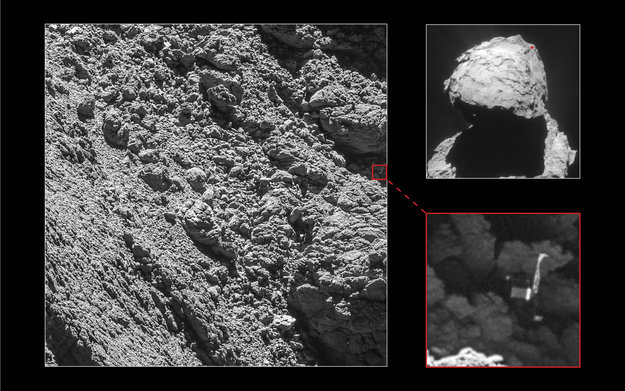Rosetta Mission’s Lost Philae Comet Lander Has Finally Been Found!
Finally found Philae!

Back in 2014, we were all very excited that the ESA had landed a spacecraft on the surface of a comet, but that excitement was tempered with a bit of uncertainty. The landing hadn’t been a complete success, and the Philae lander bounced somewhere out of sight and, sadly, out of the sunlight it needed for power. Now, with the end of the mission approaching, the lander has been found—making its data even more useful.
Data gleaned from the surface of a comet is incredible all on its own, but it’s even better when you know where on the comet the data is coming from. Until now, we only had a rough idea, but Rosetta’s OSIRIS camera has finally pinpointed Philae and given Earthbound scientists the full context of what it told us about comet 67P/Churyumov–Gerasimenko. The lander managed to complete some of its goals and send back data about organic building blocks before it eventually ran out of power, and it’s only made limited communication since then.
Now, as the mission is winding down, the Rosetta spacecraft itself prepares to make a crash landing on the comet’s surface for some final data collection on the last day of September. That put a running clock on the search for Philae, as well, and ESA scientists are relieved to have finally located it after so long. There had been a few sites in the vicinity containing objects that, at the low resolution they were imaged with, could have been Philae, and ESA’s Laurence O’Rourke, who coordinated the efforts to find the washing machine-sized robot, said in ESA’s news post, “After months of work, with the focus and the evidence pointing more and more to this lander candidate, I’m very excited and thrilled that we finally have this all-important picture of Philae sitting in Abydos.”
Holger Sierks, principal investigator for the OSIRIS camera, added, “Now that the lander search is finished, we feel ready for Rosetta’s landing and look forward to capturing even closer images of Rosetta’s touchdown site.”
(via ESA, image via ESA)
Want more stories like this? Become a subscriber and support the site!
—The Mary Sue has a strict comment policy that forbids, but is not limited to, personal insults toward anyone, hate speech, and trolling.—
Follow The Mary Sue on Twitter, Facebook, Tumblr, Pinterest, & Google+.
Have a tip we should know? tips@themarysue.com